【独家原文翻译56页版】麦肯锡大数据:创新、竞争和生产力的下一个前沿(原文翻译)
- 格式:docx
- 大小:295.34 KB
- 文档页数:50
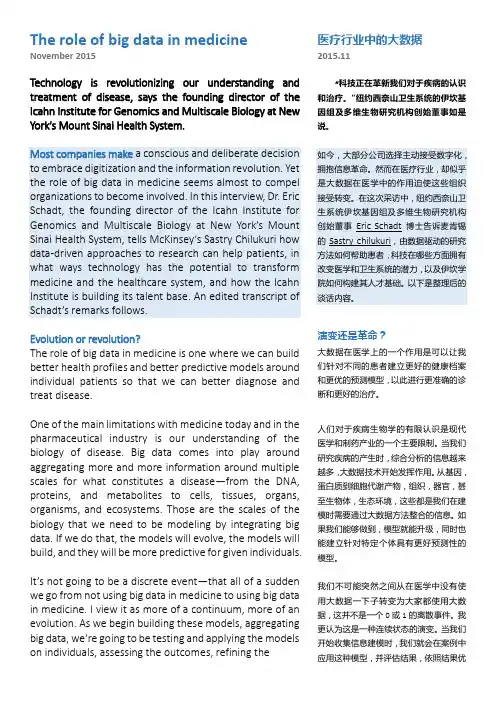
The role of big data in medicine November 2015Technology is revolutionizing our understanding and treatment of disease, says the founding director of the Icahn Institute for Genomics and Multiscale Biology at New York’s Mount Sinai Health System.Most companies make a conscious and deliberate decision to embrace digitization and the information revolution. Yet the role of big data in medicine seems almost to compel organizations to become involved. In this interview, Dr. Eric Schadt, the founding director of the Icahn Institute for Genomics and Multiscale Biology at New York’s Mount Sinai Health System, tells McKinsey’s Sastry Chilukuri how data-driven approaches to research can help patients, in what ways technology has the potential to transform medicine and the healthcare system, and how the Icahn Institute is building its talent base. An edited transcript of Schadt’s remarks follows.Evolution or revolution?The role of big data in medicine is one where we can build better health profiles and better predictive models around individual patients so that we can better diagnose and treat disease.One of the main limitations with medicine today and in the pharmaceutical industry is our understanding of the biology of disease. Big data comes into play around aggregating more and more information around multiple scales for what constitutes a disease—from the DNA, proteins, and metabolites to cells, tissues, organs, organisms, and ecosystems. Those are the scales of the biology that we need to be modeling by integrating big data. If we do that, the models will evolve, the models will build, and they will be more predictive for given individuals. It’s not going to be a discrete event—that all of a sudden we go from not using big data in medicine to using big data in medicine. I view it as more of a continuum, more of an evolution. As we begin building these models, aggregating big data, we’re going to be testing and applying the models on individuals, assessing the outcomes, refining the 医疗行业中的大数据2015.11“科技正在革新我们对于疾病的认识和治疗。
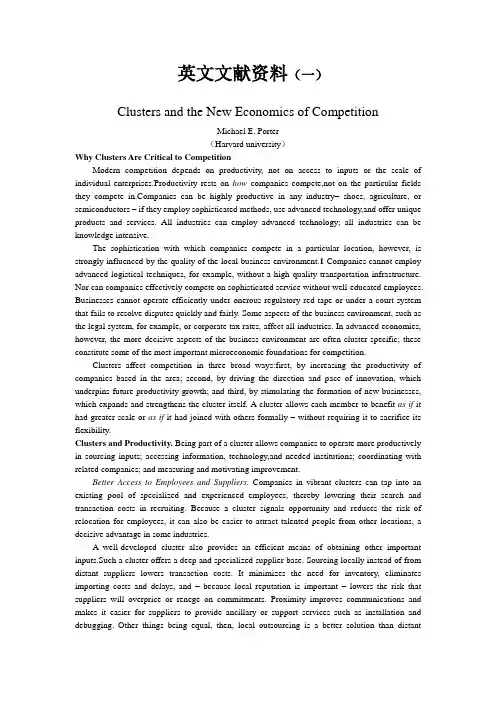
英文文献资料(一)Clusters and the New Economics of CompetitionMichael E. Porter(Harvard university)Why Clusters Are Critical to CompetitionModern competition depends on productivity, not on access to inputs or the scale of individual enterprises.Productivity rests on how companies compete,not on the particular fields they compete panies can be highly productive in any industry–shoes, agriculture, or semiconductors – if they employ sophisticated methods, use advanced technology,and offer unique products and services. All industries can employ advanced technology; all industries can be knowledge intensive.The sophistication with which companies compete in a particular location, however, is strongly influenced by the quality of the local business environment.1 Companies cannot employ advanced logistical techniques, for example, without a high quality transportation infrastructure. Nor can companies effectively compete on sophisticated service without well-educated employees. Businesses cannot operate efficiently under onerous regulatory red tape or under a court system that fails to resolve disputes quickly and fairly. Some aspects of the business environment, such as the legal system, for example, or corporate tax rates, affect all industries. In advanced economies, however, the more decisive aspects of the business environment are often cluster specific; these constitute some of the most important microeconomic foundations for competition.Clusters affect competition in three broad ways:first, by increasing the productivity of companies based in the area; second, by driving the direction and pace of innovation, which underpins future productivity growth; and third, by stimulating the formation of new businesses, which expands and strengthens the cluster itself. A cluster allows each member to benefit as if it had greater scale or as if it had joined with others formally – without requiring it to sacrifice its flexibility.Clusters and Productivity. Being part of a cluster allows companies to operate more productively in sourcing inputs; accessing information, technology,and needed institutions; coordinating with related companies; and measuring and motivating improvement.Better Access to Employees and Suppliers. Companies in vibrant clusters can tap into an existing pool of specialized and experienced employees, thereby lowering their search and transaction costs in recruiting. Because a cluster signals opportunity and reduces the risk of relocation for employees, it can also be easier to attract talented people from other locations, a decisive advantage in some industries.A well-developed cluster also provides an efficient means of obtaining other important inputs.Such a cluster offers a deep and specialized supplier base. Sourcing locally instead of from distant suppliers lowers transaction costs. It minimizes the need for inventory, eliminates importing costs and delays, and –because local reputation is important –lowers the risk that suppliers will overprice or renege on commitments. Proximity improves communications and makes it easier for suppliers to provide ancillary or support services such as installation and debugging. Other things being equal, then, local outsourcing is a better solution than distantoutsourcing, especially for advanced and specialized inputs involving embedded technology, information, and service content.Formal alliances with distant suppliers can mitigate some of the disadvantages of distant outsourcing. But all formal alliances involve their own complex bargaining and governance problems and can inhibit a company’s flexibility. The close, informal relationships possible among companies in a cluster are often a superior Arrangement.In many cases, clusters are also a better alternative to vertical pared with in-house units, outside specialists are often more cost effective and responsive, not only in component production but also in services such as training. Although extensive vertical integration may have once been the norm, a fast-changing environment can render vertical integration inefficient, ineffective, and inflexible.Even when some inputs are best sourced from a distance, clusters offer advantages. Suppliers trying to penetrate a large, concentrated market will price more aggressively, knowing that as they do so they can realize efficiencies in marketing and in service.Working against a cluster’s advantages in assembling resources is the possibility that competition will render them more expensive and scarce. But companies do have the alternative of outsourcing many inputs from other locations, which tends to limit potential cost penalties. More important, clusters increase not only the demand for specialized inputs but also their supply.Access to Specialized Information. Extensive market, technical, and competitive information accumulates within a cluster, and members have preferred access to it. In addition, personal relationships and community ties foster trust and facilitate the flow of information. These conditions make information more transferable.Complementarities. A host of linkages among cluster members results in a whole greater than the sum of its parts. In a typical tourism cluster, for example, the quality of a visitor’s experience depends not only on the appeal of the primary attraction but also on the quality and efficiency of complementary businesses such as hotels, restaurants, shopping outlets, and transportation facilities. Because members of the cluster are mutually dependent, good performance by one can boost the success of the others.Complementarities come in many forms. The most obvious is when products complement one another in meeting customers’ needs, as the tourism example illustrates. Another form is the coordination of activities across companies to optimize their collective productivity. In wood products, for instance, the efficiency of sawmills depends on a reliable supply of high-quality timber and the ability to put all the timber to use – in furniture (highest quality), pallets and boxes (lower quality), or wood chips (lowest quality). In the early 1990s, Portuguese sawmills suffered from poor timber quality because local landowners did not invest in timber management. Hence most timber was processed for use in pallets and boxes, a lower-value use that limited the price paid to landowners. Substantial improvement in productivity was possible, but only if several parts of the cluster changed simultaneously.Logging operations, for example, had to modify cutting and sorting procedures, while sawmills had to develop the capacity to process wood in more sophisticated ways. Coordination to develop standard wood classifications and measures was an important enabling step. Geographically dispersed companies are less likely to recognize and capture such linkages.Other complementarities arise in marketing. A cluster frequently enhances the reputation of a location in a particular field, making it more likely that buyers will turn to a vendor based there.Italy’s strong reputation for fashion and design, for example, benefits companies involved in leather goods, footwear, apparel, and accessories. Beyond reputation, cluster members often profit from a variety of joint marketing mechanisms, such as company referrals, trade fairs, trade magazines, and marketing delegations.Finally, complementarities can make buying from a cluster more attractive for customers. Visiting buyers can see many vendors in a single trip. They also may perceive their buying risk to be lower because one location provides alternative suppliers. That allows them to multisource or to switch vendors if the need arises. Hong Kong thrives as a source of fashion apparel in part for this reason.Access to Institutions and Public Goods. Investments made by government or other public institutions– such as public spending for specialized infrastructure or educational programs – can enhance a company’s productivity. The ability to recruit employees trained at local programs, for example, lowers the cost of internal training. Other quasi-public goods, such as the cluster’s information and technology pools and its reputation, arise as natural by-products of competition.It is not just governments that create public goods that enhance productivity in the private sector. Investments by companies –in training programs, infrastructure, quality centers, testing laboratories, and so on – also contribute to increased productivity. Such private investments are often made collectively because cluster participants recognize the potential for collective benefits.Better Motivation and Measurement. Local rivalry is highly motivating. Peer pressure amplifies competitive pressure within a cluster,even among noncompeting or indirectly competing companies. Pride and the desire to look good in the local community spur executives to attempt to outdo one another.Clusters also often make it easier to measure and compare performances because local rivals share general circumstances – for example, labor costs and local market access – and they perform similar activities. Companies within clusters typically have intimate knowledge of their suppliers’ costs. Managers are able to compare costs and employees’performance with other local companies. Additionally, financial institutions can accumulate knowledge about the cluster that can be used to monitor performance.Clusters and Innovation. In addition to enhancing productivity, clusters play a vital role in a company’s ongoing ability to innovate. Some of the same characteristics that enhance current productivity have an even more dramatic effect on innovation and productivity growth.Because sophisticated buyers are often part of a cluster, companies inside clusters usually have a better window on the market than isolated competitors do. Computer companies based in Silicon Valley and Austin, Texas, for example, plug into customer needs and trends with a speed difficult to match by companies located elsewhere. The ongoing relationships with other entities within the cluster also help companies to learn early about evolving technology, component and machinery availability, service and marketing concepts, and so on. Such learning is facilitated by the ease of making site visits and frequent face-to-face contact.Clusters do more than make opportunities for innovation more visible. They also provide the capacity and the flexibility to act rapidly. A company within a cluster often can source what it needs to implement innovations more quickly. Local suppliers and partners can and do get closely involved in the innovation process, thus ensuring a better match with customers’ requirements.Companies within a cluster can experiment at lower cost and can delay large commitments until they are more assured that a given innovation will pan out. In contrast, a company relying ondistant suppliers faces greater challenges in every activity it coordinates with other organizations –in contracting, for example, or securing delivery or obtaining associated technical and service support. Innovation can be even harder in vertically integrated companies, especially in those that face difficult trade-offs if the innovation erodes the value of in-house assets or if current products or processes must be maintained while new ones are developed.Reinforcing the other advantages for innovation is the sheer pressure – competitive pressure, peer pressure, constant comparison – that occurs in a cluster. Executives vie with one another to set their companies apart. For all these reasons, clusters can remain centers of innovation for decades.Clusters and New Business Formation.It is not surprising, then, that many new companies grow up within an existing cluster rather than at isolated locations. New suppliers, for example, proliferate within a cluster because a concentrated customer base lowers their risks and makes it easier for them to spot market opportunities. Moreover, because developed clusters comprise related industries that normally draw on common or very similar inputs, suppliers enjoy expanded opportunities.Clusters are conducive to new business formation for a variety of reasons. Individuals working within a cluster can more easily perceive gaps in products or services around which they can build businesses. Beyond that, barriers to entry are lower than elsewhere. Needed assets, skills, inputs, and staff are often readily available at the cluster location, waiting to be assembled into a new enterprise.Local financial institutions and investors, already familiar with the cluster, may require a lower risk premium on capital. In addition, the cluster often presents a significant local market, and an entrepreneur may benefit from established relationships. All of these factors reduce the perceived risks of entry – and of exit, should the enterprise fail.The formation of new businesses within a cluster is part of a positive feedback loop. An expanded cluster amplifies all the benefits I have described – it increases the collective pool of competitive resources, which benefits a ll the cluster’s members. The net result is that companies in the cluster advance relative to rivals at other locations.英文文献中文翻译(二)来源:哈佛商业评论Vol.76第6期 1998年作者:迈克·E. 波特出版时间:1998簇群与新竞争经济学(美)迈克·E. 波特为什么簇群对竞争至关重要?现代竞争取决于生产力, 而非取决于投入或单个企业的规模。
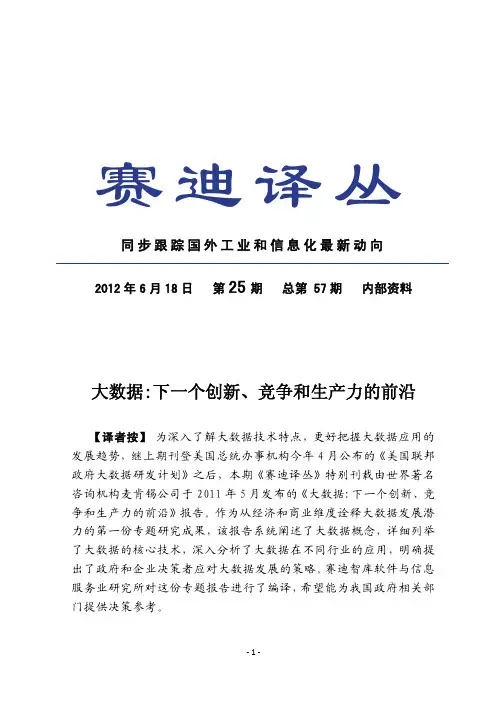
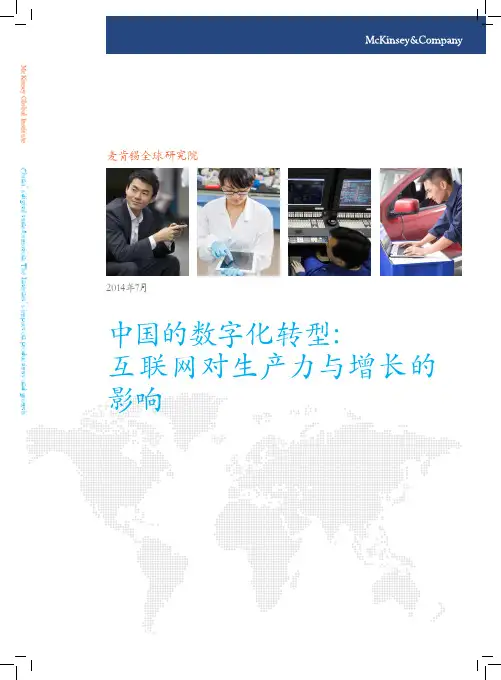


大数据的经济学研究文献综述学院:金融学院班级:13金融学硕姓名:熊美兰摘要:本文从传媒经济本体研究、产业经济学视角下的传媒经济研究、传媒经济研究工具的创新等方面来管窥近年来该领域的主要关注点以及新趋势和新突破,同时关注传媒经济学科体系研究的最新发展。
本年度传媒经济研究主题较为集中,主要是探讨传媒产业的数字化生存、全媒体转型策略与路径。
演化经济学、制度经济学、计算机和通信技术等视角和方法的引人,更加凸显了传媒经济学“跨学科”和“融合”的特征。
关键字:全媒体;三网联合;大数据;云计算;传媒经济学一、引言2012年,Twitter上每天发布超过4亿条微博,Facebook上每天更新的照片超过1000万张,Farecast公司用将近10万亿条价格记录来预测机票价格,准确率高达75%,采用该系统购票,平均每张机票可节省50美元Gartner 预测未来5年全球大数据将会增加8倍,其中80%是非结构化数据2013年世界上存储的数据将达到1.2ZB(1ZB=1024EB,1EB=1024PB,1PB=1024TB,1TB=1024GB),如果将这些数据刻录到CDR只读光盘上,并堆起来,其高度将是地球到月球距离的5倍2011年,麦肯锡公司对全世界大数据的分布作了一个研究和统计,中国2010年新增的数据量约为250PB,而欧洲约为2000PB,美国约为3500PB,大数据已经深深地充斥了人类经济社会的许多角落。
著名未来学家阿尔文托夫勒(1980)[1]很早就在其经典著作《第三次浪潮》中,将大数据热情地赞誉为第三次浪潮的华彩乐章,但是大数据成为高频词是最近一两年的事情。
随着社交网络“物联网”云计算的兴起,数据规模越来越大,2011年5月,全球知名咨询公司麦肯锡(Mckinsey andCompany)发布了《大数据: 创新、竞争和生产力的下一个前沿领域》[2]报告,标志着“大数据”时代的到来,指出数据已经渗透到每一个行业和业务职能领域,逐渐成为重要的生产因素; 而人们对于海量数据的运用,将预示着新一波生产率增长和消费者盈余浪潮的到来,2012年世界经济论坛发布了《大数据、大影响》[3]的报告,从金融服务、健康教育农业、医疗等多个领域阐述了大数据给世界经济社会发展带来的机会。
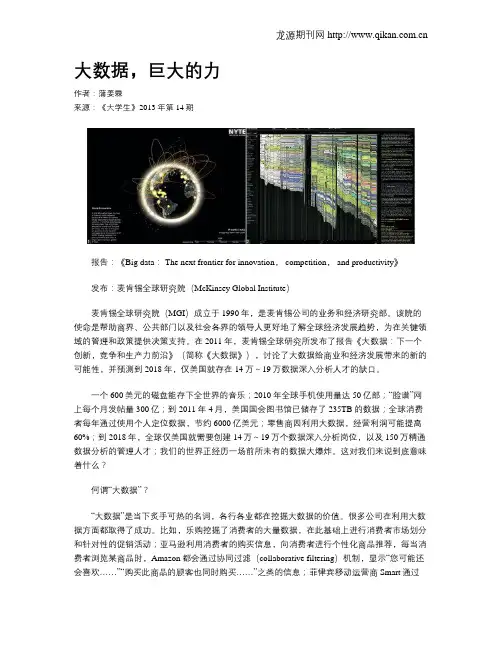
大数据,巨大的力作者:蒲姜霖来源:《大学生》2013年第14期报告:《Big data: The next frontier for innovation, competition, and productivity》发布:麦肯锡全球研究院(McKinsey Global Institute)麦肯锡全球研究院(MGI)成立于1990年,是麦肯锡公司的业务和经济研究部。
该院的使命是帮助商界、公共部门以及社会各界的领导人更好地了解全球经济发展趋势,为在关键领域的管理和政策提供决策支持。
在2011年,麦肯锡全球研究所发布了报告《大数据:下一个创新,竞争和生产力前沿》(简称《大数据》),讨论了大数据给商业和经济发展带来的新的可能性,并预测到2018年,仅美国就存在14万~19万数据深入分析人才的缺口。
一个600美元的磁盘能存下全世界的音乐;2010年全球手机使用量达50亿部;“脸谱”网上每个月发帖量300亿;到2011年4月,美国国会图书馆已储存了235TB的数据;全球消费者每年通过使用个人定位数据,节约6000亿美元;零售商因利用大数据,经营利润可能提高60%;到2018年,全球仅美国就需要创建14万~19万个数据深入分析岗位,以及150万精通数据分析的管理人才;我们的世界正经历一场前所未有的数据大爆炸。
这对我们来说到底意味着什么?何谓“大数据”?“大数据”是当下炙手可热的名词,各行各业都在挖掘大数据的价值。
很多公司在利用大数据方面都取得了成功。
比如,乐购挖掘了消费者的大量数据,在此基础上进行消费者市场划分和针对性的促销活动;亚马逊利用消费者的购买信息,向消费者进行个性化商品推荐,每当消费者浏览某商品时,Amazon都会通过协同过滤(collaborative filtering)机制,显示“您可能还会喜欢……”“购买此商品的顾客也同时购买……”之类的信息;菲律宾移动运营商Smart通过分析其渗透力、零售商覆盖率,以及城镇用户的平均工资水平等数据,将公司的业务重点放在具有最大潜力的小众市场……那么,“大数据”到底是什么呢?“大数据”是指超过现有一般数据处理软件抓取、储存、处理和分析数据的能力的数据。
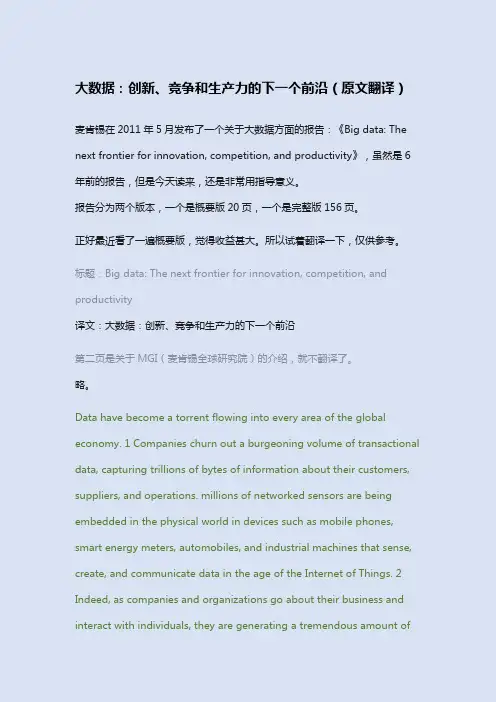
大数据:创新、竞争和生产力的下一个前沿(原文翻译)麦肯锡在2011年5月发布了一个关于大数据方面的报告:《Big data: The next frontier for innovation, competition, and productivity》,虽然是6年前的报告,但是今天读来,还是非常用指导意义。
报告分为两个版本,一个是概要版20页,一个是完整版156页。
正好最近看了一遍概要版,觉得收益甚大。
所以试着翻译一下,仅供参考。
标题:Big data: The next frontier for innovation, competition, and productivity译文:大数据:创新、竞争和生产力的下一个前沿第二页是关于MGI(麦肯锡全球研究院)的介绍,就不翻译了。
略。
Data have become a torrent flowing into every area of the global economy. 1 Companies churn out a burgeoning volume of transactional data, capturing trillions of bytes of information about their customers, suppliers, and operations. millions of networked sensors are being embedded in the physical world in devices such as mobile phones, smart energy meters, automobiles, and industrial machines that sense, create, and communicate data in the age of the Internet of Things. 2 Indeed, as companies and organizations go about their business and interact with individuals, they are generating a tremendous amount of digital“exhaust data,”i.e., data that are created as a by-product of other activities. Social media sites, smartphones, and other consumer devices including PCs and laptops have allowed billions of individuals around the world to contribute to the amount of big data available. And the growing volume of multimedia content has played a major role in the exponential growth in the amount of big data (see Box 1, “What do we mean by ‘big data’?”). Each second of high-definition video, for example, generates more than 2,000 times as many bytes as required to store a single page of text. In a digitized world, consumers going about their day—communicating, browsing, buying, sharing, searching—create their own enormous trails of data.译文:数据已成为流入全球经济各个领域的激流。


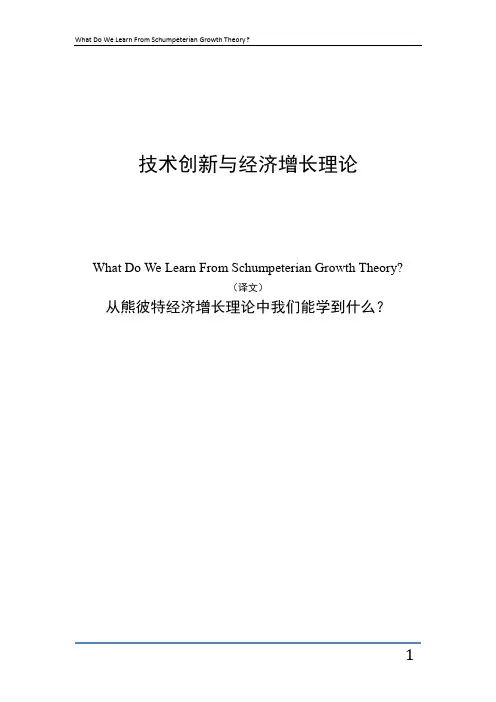
技术创新与经济增长理论What Do We Learn From Schumpeterian Growth Theory?(译文)从熊彼特经济增长理论中我们能学到什么?文献简介What Do We Learn From Schumpeterian Growth Theory?作者:Philippe Aghion,Ufuk Akcigit,Peter Howitt发表机构:CESIS Electronic Working Paper Series,Paper No.298 发表时间:2013年2月15日原文网址:/p/hhs/cesisp/0298.html被引用次数:9目录摘要 (4)1.绪论 (5)2.熊彼特式的增长:基本模型 (6)2.1模型设定 (6)2.2模型求解 (7)2.2.1套利方程研究和劳动力市场出清方程 (7)2.2.2均衡利润,总研发和增长 (8)3.增长 (10)3.1从跨越到逐步创新 (10)3.1.1争论 (10)3.1.2家庭 (11)3.1.3跨部门生产函数 (11)3.1.4技术和创新 (12)3.2在同水平和水平不一部门,均衡利润和竞争 (12)3.3熊彼特式效应和逃避竞争效应 (14)3.3.1结构效应和倒U型 (15)3.4预测 (16)4.熊彼特增长和公司动态 (18)4.1模型设定 (18)4.2模型求解 (20)4.2.1静态的生产决策 (20)4.2.2动态的创新决策 (20)4.2.3自由进入 (21)4.2.4劳动力市场出清 (21)4.3均衡增长率 (22)4.4预测 (22)5.增长和发展 (25)5.1创新与模仿和适当性制度的概念 (25)5.2关于适当的增长政策和制度的进一步证明 (26)5.3创造性破坏的政治经济 (29)5.3.1形式论证 (29)5.3.2证据 (32)6.熊彼特式的波动 (33)6.1重回基本的熊彼特模型 (34)6.2GPTs增长模型 (35)6.3GPT和工资不平等 (37)6.4预测 (38)7.结论 (39)从熊彼特的经济增长理论中我们能学到什么?摘要熊彼特经济增长理论通过将熊彼特“创造性破坏”思想模型化,来展开对这一思想的研究。
麦肯锡产业发展趋势麦肯锡(McKinsey)是全球顶尖的管理咨询公司之一,它在各行各业都拥有深入的行业知识和丰富的经验。
麦肯锡的专家团队定期发布报告,分析各个产业的发展趋势和未来发展方向,为企业提供战略指导和决策支持。
本篇文章将以互联网、人工智能、生物科技和可持续发展为例,探讨麦肯锡认为的产业发展趋势。
一、互联网产业发展趋势互联网产业是当前全球最具影响力的产业之一,它正在以惊人的速度改变着各行各业的运营模式和商业逻辑。
关于互联网产业的发展趋势,麦肯锡总结了以下几点:1. 移动互联网的普及:智能手机和移动网络的普及,将进一步推动移动互联网应用的发展。
随着4G和5G技术的普及,我们可以预见到更多的移动互联网应用将会涌现,为用户提供更加便捷的服务。
2. 人工智能在互联网产业中的应用:人工智能技术的迅速发展,使得其在互联网产业中的应用逐渐增多。
无论是自动驾驶、智能客服还是智能推荐系统,人工智能都将大幅度提升互联网产业的效率和用户体验。
3. 云计算技术的应用:云计算技术将进一步推动互联网产业的发展。
通过云计算,企业可以将大量的数据存储和计算任务外包给云服务商,降低了企业的成本和风险,并且可以更加灵活地调整资源的配置。
4. 数据驱动的商业模式:互联网产业以数据为基础,数据驱动的商业模式将成为主流。
企业通过大数据分析,可以更好地了解用户需求并提供个性化的产品和服务,提高用户满意度和品牌忠诚度。
二、人工智能产业发展趋势人工智能是当前科技界最热门的领域之一,它正在以惊人的速度改变着人们的生活和工作方式。
麦肯锡认为,人工智能产业的发展趋势主要有以下几点:1. 垂直领域的应用:随着人工智能技术的不断进步,人工智能在各个垂直领域的应用将大幅度增加。
例如,医疗健康、金融、交通运输等领域都可以通过人工智能技术实现更高效、更精准的管理和决策。
2. 自动化和智能化的生产模式:人工智能技术的应用将推动生产模式的变革。
例如,工厂生产线可以通过人工智能技术实现自动化生产,提高生产效率和质量。
全球只有一张损益表——解读麦肯锡核心竞争力与那些世界著名的跨国公司相比,麦肯锡显然是低调的,既不作广告,也很少在媒体上主动宣传自己;由于商业保密性原则,麦肯锡更不以客户名单为自己做宣传。
6月7日,麦肯锡公司董事长兼全球总裁顾磊杰(RAJAT K.GUPTA)先生来华访问。
与其他20多位跨国公司总裁一样,顾磊杰先生是清华大学经济管理学院院长顾问委员会委员,这次来华就是专程参加顾问会议的。
也许是因为麦肯锡的头衔,顾磊杰先生还在哈佛大学、芝加哥大学、西北大学Kellogg管理学院、沃顿商学院、MIT斯隆管理学院等世界知名学府担任监事、董事或顾问委员会委员一类的职务。
作为一位印裔美国人,顾磊杰还担任印度商学院董事会主席和印度基金会主席的职务。
作为一家私人合伙制的咨询公司,麦肯锡培养一位董事合伙人需要大约7-8年的时间,顾磊杰先生于1973年加入麦肯锡,1980年升任董事,1981年起担任麦肯锡北欧分公司总经理。
在麦肯锡这样一个高手云集的地方,一个“人人都具有领导才能”的地方,什么样的人才能成为他们的领导呢?而顾磊杰自1994年开始,却连续三次当选麦肯锡董事长兼全球总裁。
与那些运用“注意力经济”原理吸引公众注意的全球大公司相比,麦肯锡还有其颇为“神秘”的一面。
除了上述的“低调”,还有就是为外界广为赞赏又鲜为人知的麦肯锡的核心竞争力。
北京大学光华管理学院张维迎教授在分析企业的核心竞争力时认为,企业最重要的竞争力是看这个企业在多大程度上积累了互补性知识。
张认为,麦肯锡的某一个咨询顾问可能不是最优秀的,但这个团队组合起来就是世界最强的,麦肯锡的竞争力在于他的全球一体化,在于他建的全球资源共享,这是别人偷不去、买不来、拆不开、带不走的东西。
张的这个分析,在我与顾磊杰先生的讨论中得到了印证。
在全球前150家大公司中,有100家是麦肯锡公司的客户。
这家1926年成立于芝加哥的私人合伙制咨询公司,目前已经发展成为全球性的咨询网络,在44个国家设有85家分公司,拥有7000多名咨询顾问。
大数据下一个创新、竞争和生产力的前沿大数据:下一个创新、竞争和生产力的前沿2013-08-02 04:45 [编辑]:朱娟[作者]:天云大数据近年来,全球著名咨询公司麦肯锡陆续发布了多份有关“大数据”的研究报告,其中一份名为“大数据:下一个创新、竞争和生产力的前沿”一文认为只要给予适当的政策支持,“大数据”将促进生产力增长并推动创新。
这里我们将介绍部分重要内容。
该研究报告指出,分析“大数据”将成为竞争的关键。
如果再辅以正确的政策与有利条件,“大数据”将引发新一轮的生产力增长与创新。
麦肯锡研究了“大数据”中尚未开发的巨大价值。
例如,充分利用“大数据”的零售商将能够使营业利润率提高60%以上。
“大数据”在公共领域也有极大潜力可以挖掘。
如果美国医疗保健行业有效利用“大数据”,就能把成本降低8%左右,从而每年创造出3000多亿美元的产值。
在欧洲发达国家,如果政府利用“大数据”提高运作效率,那么将节省至少1000亿欧元(约1490亿美元)的成本。
而利用个人位置数据(personal location data) 提供的服务将可以创造6000亿美元的消费者剩余(consumer surplus)。
数据应用是ICT 带来的一项长期性影响,然而当前“大数据”所产生的影响的规模与范围正处于转折点。
企业产生的信息量在不断增长,再加上多媒体、社会化媒体和物联网的兴起,在可预见的未来,数据量将呈指数型增长。
目前“大数据”对各个经济领域都产生了影响。
“大数据”将创造新的增长机会,以及促进新型公司的诞生。
这些公司将获取并处理大量有关产品与服务、买家与供货商、消费者喜好与意图的信息。
麦肯锡对医疗保健、零售、公共领域、制造、个人位置数据这五大领域进行了重点分析,提出了可以利用“大数据”的五种方法:(1)以时效性更高的方式向用户提供“大数据”。
在公共领域,跨部门提供“大数据”能大幅减少检索与处理时间。
在制造业,集成来自研发、工程、制造单元的数据可以实现并行工程,缩短产品投放市场的时间。
【精华】两分钟看懂麦肯锡大数据分析报告>>>>写在文首报告来源:麦肯锡全球研究院报告标题:The Age of Analytics: Competing in a Data-Driven World本文为编译,版权归原作者和原出处所有。
报告原文为英文,如果存在翻译问题欢迎指正!2016年12月,麦肯锡全球研究院(McKinsey Global Institution,MGI)发表了一份名为《分析的时代:在大数据的世界竞争(The Age of Analytics: Competing in a Data-Driven World)》的报告。
该报告指出近年来数据量成指数型增长,发展出更复杂的算法,计算机的储存能力也得到提升,这些趋势伴随着技术日新月异的变化,商业模式也受到颠覆式影响。
五年前,MGI就指出大数据分析将在五大领域有很大的增长潜力,分别是基于定位的服务(Location-based service)、美国零售业(US retail)、制造业(Manufacturing)、欧盟公共部门(The EU public sector)以及美国健康医疗领域(US health care)。
五年后,MGI再次考量这个议题,发现当年预测的大数据分析能实现的潜在价值,在五个领域取得的进步是不均衡的。
基于定位的服务实现了2011年所预测的潜在价值的50%-60%,而在公共领域和健康医疗领域,大数据分析只实现了10%-20%的预测潜在价值,主要的障碍在于分析、技术人才的缺乏,数据处理、整合以及共享的问题等。
在公司层面,每个公司对于数据分析的应用是不同程度的,但分析人才却持续匮乏。
根据麦肯锡最近的一个公司报告显示,来自不同地区不同行业将近一半的高管表示数据分析人才的空缺比其他任何角色的空缺都更难补,40%的高管认为留住这些人才同样是个问题。
在美国,2012年到2014年数据科学家的平均工资每年平均增长约16%,远远高于美国劳工部统计的不到2%的所有工种的名义工资平均增长率。
大数据:创新、竞争和生产力的下一个前沿(原文翻译)麦肯锡在2011年5月发布了一个关于大数据方面的报告:《Big data: The next frontier for innovation, competition, and productivity》,虽然是6年前的报告,但是今天读来,还是非常用指导意义。
报告分为两个版本,一个是概要版20页,一个是完整版156页。
正好最近看了一遍概要版,觉得收益甚大。
所以试着翻译一下,仅供参考。
标题:Big data: The next frontier for innovation, competition, and productivity译文:大数据:创新、竞争和生产力的下一个前沿第二页是关于MGI(麦肯锡全球研究院)的介绍,就不翻译了。
略。
Data have become a torrent flowing into every area of the global economy. 1 Companies churn out a burgeoning volume of transactional data, capturing trillions of bytes of information about their customers, suppliers, and operations. millions of networked sensors are being embedded in the physical world in devices such as mobile phones, smart energy meters, automobiles, and industrial machines that sense, create, and communicate data in the age of the Internet of Things. 2 Indeed, as companies and organizations go about their business and interact with individuals, they are generating a tremendous amount of digital“exhaust data,”i.e., data that are created as a by-product of other activities. Social media sites, smartphones, and other consumer devices including PCs and laptops have allowed billions of individuals around the world to contribute to the amount of big data available. And the growing volume of multimedia content has played a major role in the exponential growth in the amount of big data (see Box 1, “What do we mean by ‘big data’?”). Each second of high-definition video, for example, generates more than 2,000 times as many bytes as required to store a single page of text. In a digitized world, consumers going about their day—communicating, browsing, buying, sharing, searching—create their own enormous trails of data.译文:数据已成为流入全球经济各个领域的激流。
公司制造了数量庞大的交易数据,捕获了数万亿字节的有关其客户、供应商和公司运营的信息。
数百万的网络传感器被嵌入在诸如移动电话、智能电表、汽车和工业机器等实体设备中,它们在物联网时代感知、创建和传送着数据。
事实上,随着公司和组织开展他们的业务并与个人进行互动,他们正在产生大量的“排放数据”,即作为其他活动的副产品而产生的数据。
社交媒体、智能手机和其他消费设备,包括PC和笔记本电脑,使世界上数十亿的个人能够贡献大量数据。
而且越来越多的多媒体内容在大数据的指数增长中发挥了重要作用(见插文1,“大数据”是什么?)。
例如,每秒的高清视频生成的字节数量是存储单页文本所需的2000倍。
在数字世界中,消费者每天都在进行通信、浏览、购买、共享和搜索——创建自己巨大的数据流。
Box 1. What do we mean by "big data"?“Big data”refers to datasets whose size is beyond the ability of typical database software tools to capture, store, manage, and analyze. This definition is intentionally subjective and incorporates a moving definition of how big a dataset needs to be in order to be considered big data—i.e., we don’t define big data in terms of being larger than a certain number of terabytes (thousands of gigabytes). We assume that, as technology advances over time, the size of datasets that qualify as big data will also increase. Also note that the definition can vary by sector, depending on what kinds of software tools are commonly available and what sizes of datasets are common in a particular industry. With those caveats, big data in many sectors today will range from a few dozen terabytes to multiple petabytes (thousands of terabytes).译文:插文1.“大数据”是什么?“大数据”是指数据量级超过传统数据库软件工具捕获、存储、管理和分析能力的数据集。
这个定义是主观的,并且包含了一个数据集量级的动态定义(超过这个大小才会被认为是大数据)——也就是说,我们没有定义一个确定的值(比如多少TB)。
我们认为随着技术的进步,被认定为“大数据”的数据集的大小数量级也将增加。
还要注意,这个数据集大小的定义会因行业而异,它取决于这些行业中普遍使用的软件工具不同以及通常的数据集的大小。
基于这些认知,今天许多行业的大数据的数据集大小范围将从几十TB到几PB(几千TB)。
In itself, the sheer volume of data is a global phenomenon—but what does it mean? Many citizens around the world regard this collection of information with deep suspicion, seeing the data flood as nothing more than an intrusion of their privacy. But there is strong evidence that big data can play a significant economic role to the benefit not only of private commerce but also of national economies and their citizens. Our research finds that data can create significant value for the world economy, enhancing the productivity and competitiveness of companies and the public sector and creating substantial economic surplus for consumers. For instance, if US health care could use big data creatively and effectively to drive efficiency and quality, we estimate that the potential value from data in the sector could be more than $300 billion in value every year, two-thirds of which would be in the form of reducing national health care expenditures by about 8 percent. In the private sector, we estimate, for example, that a retailer using big data to the full has the potential to increase its operating margin by more than 60 percent. In the developed economies of Europe, we estimate that government administration could save more than €100 billion ($149 billion) in operational efficiency improvements alone by using big data. This estimate does not include big data levers that could reduce fraud,errors, and tax gaps (i.e., the gap between potential and actual tax revenue).译文:数据量激增本身是一个全球现象,但它是意味着什么呢?全球范围内有许多人对这种信息收集持深深的怀疑态度,认为数据泛滥只不过是对他们隐私的侵犯。